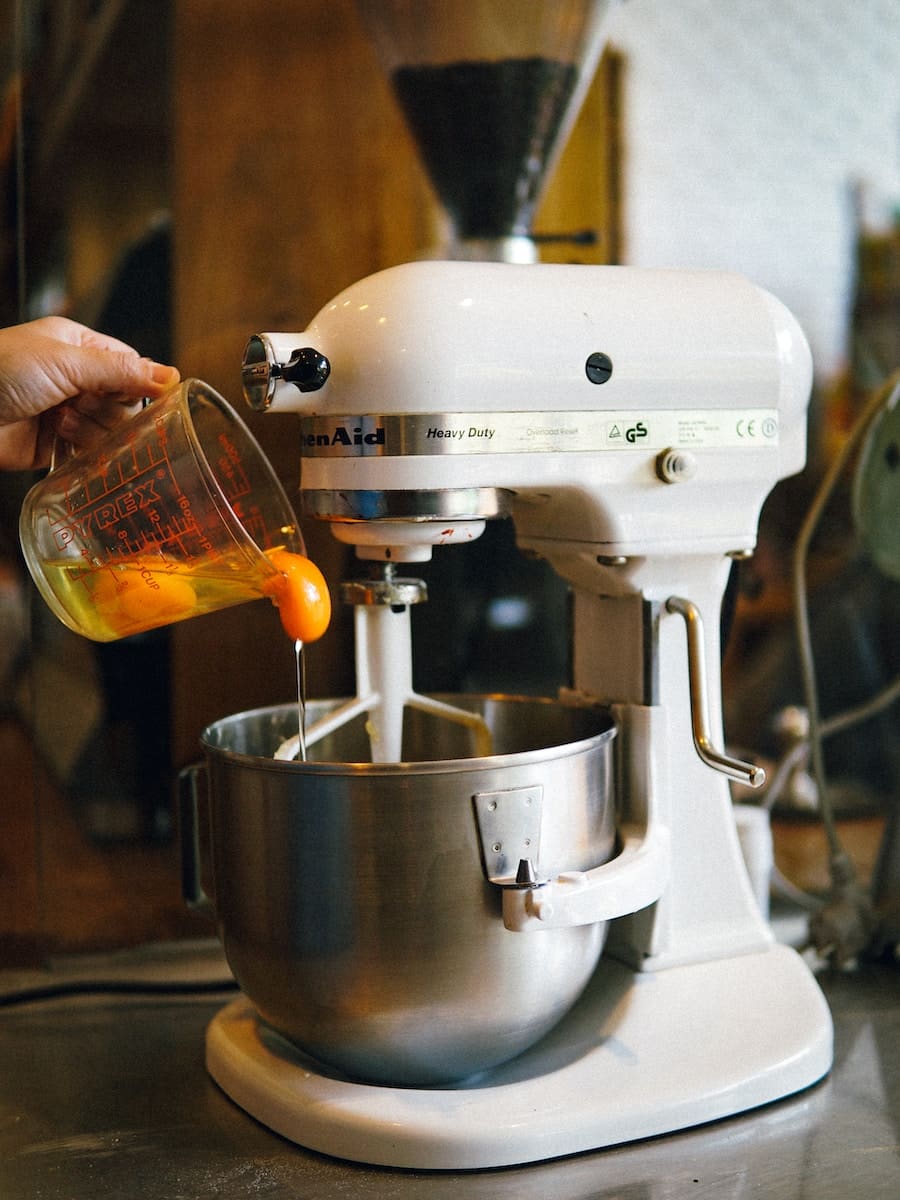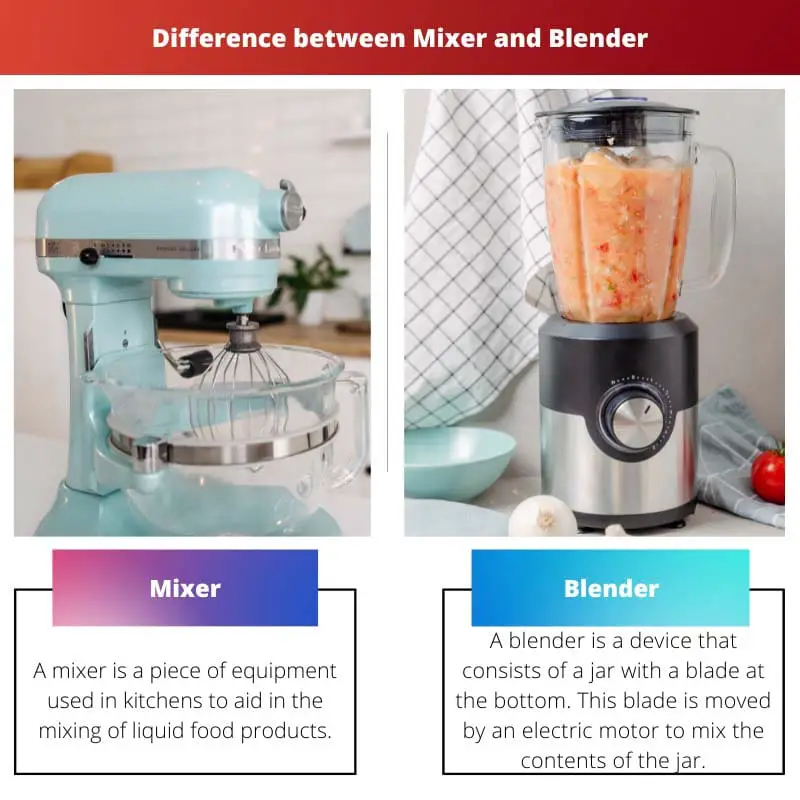Working in the kitchen has become simpler and more convenient as technology has advanced.
Kitchen appliances such as mixers and blenders have made recipe preparation faster and more efficient, saving people all over the world a lot of time and effort.
Many individuals are unable to distinguish between a blender and a mixer due to evident visual and functional similarities.
However, the work for which a blender is to be employed in a kitchen differs from that of a mixer due to the fundamental difference in the construction of a blender and a mixer.
Key Takeaways
- Mixers combine ingredients by stirring, beating, or whipping, while blenders process ingredients into a smooth consistency.
- Mixers are more suitable for mixing dough, batter, and other thick mixtures, while blenders are ideal for making smoothies, soups, and purées.
- Stand and hand mixers are common, while countertop blenders and immersion blenders are popular blender options.
Mixer vs Blender
A mixer is a kitchen product which is used to mix two or more ingredients. In a mixer, beaters are attached with the motor that are used for mixing. A fluffy mixture can be prepared with a mixer. Blender is used to blend or make small pieces of solid food. In a blender, there is a blade in a container. Blender speed can be adjusted according to the type of food.

A mixer is a piece of equipment used in kitchens to aid in mixing liquid food products. It all started with an eggbeater and has evolved into a hand mixer powered by electricity.
Modern mixers include a beater (two) that may be immersed in a liquid-containing container, while the other end of the mixer is housed within a unit that contains a motor.
A blender is a device that consists of a jar with a blade at the bottom. An electric motor moves this blade to mix the contents of the jar.
The blender container is largely constructed of clear plastic with markings to enable exact proportions. However, stainless steel and glass containers are also popular.
Comparison Table
| Parameters of Comparison | Mixer | Blender |
|---|---|---|
| Function | Combines multiple ingredients into a single substance. | Breaks down solid foods into smaller pieces. |
| Mechanism | One or two beaters with a motor that rotates them. | A container with a blade that is operated by a motor. |
| Uses | Cake batter, beating eggs, etc. | Smoothies, dips, sauces, etc. |
| Types | Hand mixer, stand mixer. | Immersion blender, countertop blender |
| Diversity | More diverse | Less diverse |
What is Mixer?
Today, most Indian kitchens have a mixer grinder. On the other hand, a mixed grinder has fixed blades that revolve at different speeds, which is a constraint to some extent. However, for everyday usage, a mixer grinder is ideal.
A kitchen mixer is used to grind, beat, stir, and whip food. It is a more effective method of combining substances than stirring with a spoon.
A hand mixer has two whisks affixed to it, and a stand mixer includes whisks, paddles, a dough hook, and other accessories.
Hand mixers should be lightweight enough to be still comfortable to handle for 5 to 10 minutes. They are intended to alleviate pressure on your forearms.
Mixer bowls come in a variety of sizes, but the most common are 4.5 to 5.5 quarts. A mixer ought to be strong and long-lasting.
With the push of a button on the body, the beater on a mixer revolves at high speeds, completing the mixing or beating task in seconds.
The mixer may be removed and cleaned under running water before being reused.
A mixer is not the same as the other kitchen gadgets we’ve known. You can always buy hand beaters if you can’t afford a stand mixer.
They operate just as well as a stand mixer, but a stand mixer is quicker and more efficient. Furthermore, hand beaters cannot be used to produce dough, which is another significant function of a stand mixer.

What is Blender?
A blender contains high-speed revolving blades that are ideal for liquefying or cutting food into small bits.
Some blenders require the addition of a liquid to solid food particles to move them and bring them into touch with the blade, allowing them to be chopped and sliced uniformly.
The speed of a blender motor may be adjusted based on the food to be mixed. Blenders may be used to smash ice, produce purees, dissolve solids into liquids, puree boiling vegetables, and so on.
Some blenders allow you to change the blades to do numerous activities in the kitchen.
The appliance comprises four main elements that work together to form a whole: the lid, blades, pitcher, and base (along with the motor).
Vibration dampers attach a fan-cooled electric motor to the housing, and a short output shaft enters the upper housing and meshes with the blade assembly.
The blades gradually combine all of the liquid and solid materials perfectly, leaving no lumps left.
It houses the blender’s power controls over the base. A blender consumes around 0.4 kWh of power. Unlike in a food processor, the blades of a blender are dull. The appliance is reasonably priced.
Because of the blender’s unique ability to retain fibres, the liquid is somewhat thicker than juice and is commonly used to prepare smoothies.
The liquid can be filtered through a sieve to eliminate the larger-sized surplus fibres. It might be made of glass, plastic, or metal.
Because of the presence of fibres, the liquid is good for the body. It not only slows digestion but also aids in the removal of toxins and other toxic items from the digestive tract.

Main Differences Between Mixer and Blender
- A mixer makes a single substance by combining different ingredients; a blender makes smaller pieces of food by breaking down food.
- A mixer has 1-2 beaters attached that are immersed in a pan, and it has a motor that helps rotate them. On the other hand, a blender has a blade in a container that is rotated with the help of a motor present at the base.
- Mixers can be used to make cookie batters, bread, beaten eggs, mashed potatoes, etc. In contrast, a blender is used to make dips, sauces, purees, smoothies, etc.
- Mixers can be divided into a hand mixer or a stand mixer. Types of blenders can be immersion blenders and countertop blenders.
- Mixers are more diverse than blenders, which means that they can make a wider variety of things.




